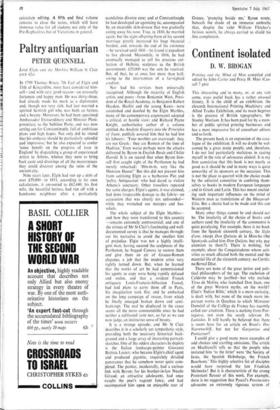Paltry antiquarian
PETER QUENNELL
Lord Elgin and the Marbles William St Clair (our 42s)
In 1799 Thomas Bruce, 7th Earl of Elgin and 11th of Kincardine, must have considered him- self—and with very good reason—an unusually fortunate and happy man. He was thirty-three, had already made his mark as a diplomatist and, though not very rich. had just married a spirited Scottish girl who was both an heiress and a beauty. Moreover, he had been appointed Ambassador Extraordinary and Minister Pleni- potentiary to the Sublime Porte, and was now setting out for Constantinople, full of ambitious plans and high hopes. Not only did he intend that his embassy should be particularly splendid and impressive; but he also expected to confer `some benefit on the progress of taste in England' by dispatching a group of experienced artists to Athens, whence they were to bring back casts and drawings of all the masterpieces they could discover among the ruins of the ancient city.
Nine years later, Elgin had run up a debt of over £39,000—in 1811, according to his own calculations, it amounted to £62,440; his first wife, the beautiful heiress, had run off with a handsome neighbour after a particularly
scandalous divorce case; and at Constantinople he had developed an agonising tic, accompanied by an incurable skin-disease that was gradually eating away his nose. True, in 1810, he married again; but the eight offspring born of his second marriage greatly increased his huge financial burden; and, towards the end of his existence —he survived until 1841—he found it expedient to live abroad. Meanwhile, in 1816, he had eventually managed to sell his precious col- lection of Hellenic sculpture to the British government; £35,000 was the sum he received. But, of that, he at once lost more than half, owing to the intervention of a far-sighted creditor.
Nor had his services been universally recognised. Although the majority of English artists and poets—from Benjamin West, Presi- dent of the Royal Academy, to Benjamin Robert Haydon, Hazlitt and the young Keats—were astonished and dazzled by the Elgin Marbles, many of the contemporary cognoscenti adopted a critical, or hostile view; and Richard Payne Knight, authoritative author of a volume entitled An Analytic Enquiry into the Principles of Taste, publicly assured him that he had lost his labours: 'Your marbles are overrated: they are not Greek : they are Roman of the time of Hadrian.' Even worse perhaps were the attacks delivered by Byron in English Bards and Childe Harold. It is on record that when Byron him- self first caught sight of the Parthenon he had merely remarked : 'Hm-m-m, very like the Mansion House!' But this did not prevent him from satirising Elgin as a barbarous Pict and 'paltry Antiquarian' who had dared to violate Athena's sanctuary. Other travellers repeated the same charges; Elgin's agents, it was claimed, had done irreparable damage to the fabric—an accusation that was clearly not unfounded— while they wrenched out metopes and bas- reliefs.
The whole subject of the Elgin Marbles— and how they were transferred to this country —remains extremely controversial; and one of the virtues of Mr St Clair's fascinating and well- documented survey is that he manages through- out his narrative to avoid the smallest hint of prejudice. Elgin was not a highly intelli- gent man; having secured the sculptures of the Parthenon, he begged Canova to restore them and give them an air of Graeco-Roman elegance, a job that the modern artist very rightly turned down. But, when he learned that the works of art he had commissioned his agents to copy were being rapidly defaced and stolen, and that a resident French antiquary Louis-Francois-Sebastien Fauvel, had laid plans to carry them off to Paris, his imagination took fire; and he embarked on the long campaign of rescue, from which he finally emerged broken down and semi- bankrupt. The zeal he displayed in the cause seems all the more commendable since he had neither a cultivated taste nor, so far as we can now judge, an instinctive sense of beauty.
It is a strange episode; and Mr St Clair 'describes it in a scholarly yet sympathetic style, providing both the necessary historical back- ground and a large array of interesting portrait- sketches. One of the oddest characters he depicts is the Italian landscape-painter Giovanni Battista Lusieri, who became Elgin's chief agent and produced gigantic, exquisitely detailed panoramas that he somehow never quite com- pleted. The painter, incidentally, had a curious link with Byron; for his brother-in-law Nicolo Giraud, an attractive adolescent, had once caught the poet's vagrant fancy, and had accompanied him upon an enjoyable tour of
Greece, 'prancing beside me,' Byron wrote, beneath the shade of an immense umbrella that, despite the valet William Fletcher's furious scowls, he always carried to shield his , • fine complexion.






































 Previous page
Previous page